Category: photos
10/22/05 05:20 - 44ºF - ID#28209
Walk
I thought some of you might like to see some pictures I took on a previous walk down elmwood of some nice cars.
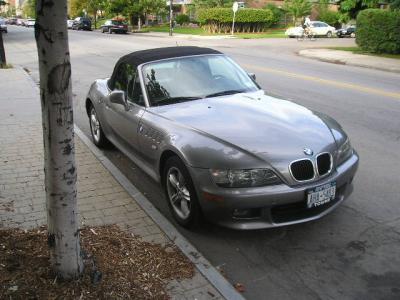
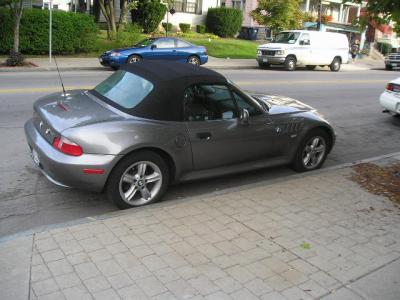
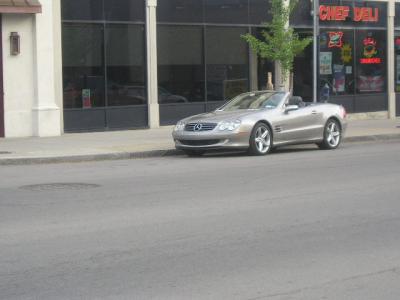
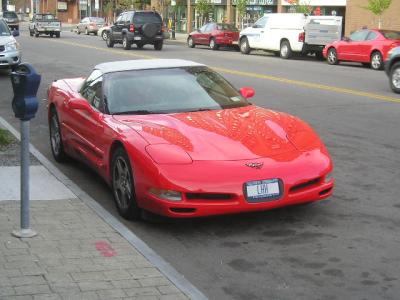
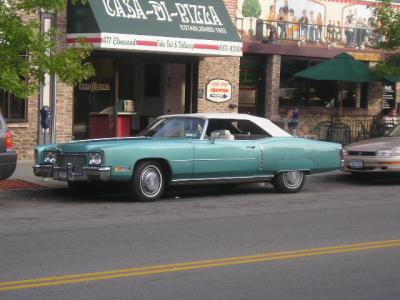
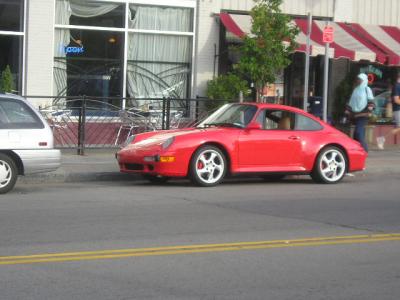
Permalink: Walk.html
Words: 162
Location: Buffalo, NY
Category: tv
10/21/05 07:39 - 55ºF - ID#28208
South Park Interview
In the topical world of 'South Park,' the weekly deadlines never end
By JAKE COYLE
Associated Press
10/21/2005

Trey Parker and Matt Stone, right, are in their ninth season.
NEW YORK - With the political relevance of "The Daily Show" and the huge DVD sales (and subsequent hiatus) of "Chappelle's Show," it's easy to forget about that other Comedy Central show, "South Park."
But Matt Stone and Trey Parker's crude cartoon began its ninth season this week, and it remains the network's most-watched program. It is, perhaps, the most manic thing on TV, with entire episodes created just days before they air.
With a ripped-from-the-headlines approach, it's the "Law & Order" of comedy. The first episode, "Two Days Before the Day After Tomorrow," tackled Hurricane Katrina - by way of the neighboring town flooding.
Parker, who turned 36 Wednesday, and Stone, 34, last month inked a deal for three more seasons and "South Park" has begun appearing in syndication in some markets - both of which assure the world of Cartman, Stan, Kyle and the rest will continue to expand.
Q: Cartman once described independent movies as "gay cowboys eating pudding." Now we have "Brokeback Mountain," an upcoming movie by Ang Lee about gay cowboys.
Stone: If they have pudding in that movie, I'm going to lose my mind.
Parker: No, if there's pudding eating in there, we're going to sue.
Q: Are you guys prophets?
Stone: No, but Cartman is. (Laughs) We went to Sundance a lot in the mid-to-late '90s, and you could just tell it was going toward gay cowboydom.
Q: It's a fast process for you, isn't it?
Parker: It is. We take a lot of time before just to come up with the broad ideas, but until the Thursday before that Wednesday, that's when we really sit down and go "OK, how can we tell this story?" And it leaves us a lot of room, too. A lot of times on a Thursday, we'll sit down and go, "Hey, have you seen this Terri Schiavo thing? This is huge, we should do a story about that."
Q: Sometimes "South Park" is quite topical.
Parker: Yeah, the reason we're able to do that is it's still just Matt and I really doing most everything. We still write, direct and edit every episode ourselves. . . . We can sit there on a Tuesday night and (rewrite the third act), run in the booth next door, record all the voices, get the storyboards together, edit it and see it in a couple hours. It's pretty amazing. It's pretty amazing, too, having done it almost nine years.
Q: Does the fast process backfire sometimes?
Stone: I actually think that makes the show better in a weird way. It's kind of a punk-rock ethic. Like albums that are too produced, you can tell they produced all the magic out of it.
Parker: It's a little more White Stripes.
Q: Are you surprised at the longevity of "South Park"?
Stone: It's totally crazy. When we first did the show, we thought it would be six episodes and then we'd be done - and now we're in our ninth season and signed up to do three more years.
Q: What do you do to keep it fresh?
Parker: It's so much fun, since we still do everything, you can sort of see our growth as writers. When we started this show, we knew how to do funny, outrageous stuff, but we didn't know how to write.
Q: Is there something you're personally sensitive about or is everything fair game?
Stone: We have a really funny breast cancer episode coming up. (Laughs) I just think it's not contradictory to make fun of something and be sensitive about it. It's just the way we examine the world. "Sensitive" isn't the right word, but we actually have thoughts and feelings about all this stuff; it's not just destruction-oriented.
Parker: Just last week we were on a plane and we were pretty positive we were going to die - and we were making jokes. It really, really felt like the end, and we were making jokes.
Q: Are you thinking about another movie?
Parker: Um, no.
Stone: "Team America" almost killed us. We'd like to figure out a way to do our own movies, but not die doing them, and maybe help some other people produce their movies, like graduate to the next level because we are getting up there in age.
Q: What about a live-action movie?
Stone: Like "Deuce Bigalow: Male Gigolo"? (laughs) That's what we should do, really.
Parker: We could make so much money if we would just write scripts like that and go shoot them and put big stars in them. But, first of all, we hate actors. And second, I just can't imagine being on a set of a movie like "Deuce Bigalow."
Permalink: South_Park_Interview.html
Words: 1000
Location: Buffalo, NY
Category: tourism
10/21/05 06:37 - 55ºF - ID#28207
Canada insentives
Canadians offered $50 if they stay overnight to shop here
By MICHELLE KEARNS
News Business Reporter
10/21/2005
A new regional collaboration of hotels and shops will give away $50 shopping certificates to encourage more Canadians to come spend the night and spend more of their increasingly-valuable dollars on this side of the border.
"I thought, "What the heck, we'll give it a try,' " said Ed Vidler, president of Vidler's 5 & 10, a 75-year-old store in East Aurora known for its old-fashioned penny-candy charm. "I call 'em the bonus extra. They're wonderful to have."
Vidler came to downtown Buffalo Thursday to speak during the formal announcement of the new $20,000 "Shopping is Hopping in Buffalo" effort, organized by the Buffalo Niagara Convention & Visitors Bureau.
The campaign will be promoted on the Toronto CHUM-FM radio station and by the local WNED public television station, which broadcasts to Canada, in hopes of selling 500 packages before the deal ends in March.
The $50 certificate is given with a hotel booking and works in the local shopping districts of East Aurora, Buffalo's Elmwood Village and Williamsville's Main Street and three of the area malls: Eastern Hills, Walden Galleria and McKinley Mall.
Next year, the bureau plans a second campaign to sell people in Southern Ontario on the idea of making a trip for the Frank Lloyd Wright houses and the other local art, architecture and culture features.
"We think that's a prime market for us," said Edward Healy, director of communications for the bureau.
Already the Walden Galleria reports that more cars with Canadian license plates have been appearing in the parking lot - 15 to 20 percent, compared to 8 to 12 percent a few years ago.
One hotelier, of Cheektowaga's Sleep Inn, called travel agents offering the new deal and got 14 bookings at $110 a night for November, an attractive month for its traditional "Black Friday" sales day after Thanksgiving.
For Torontonian Jamie Patterson, shopping in the Buffalo-area is an easy draw. His dollars are now worth about 85 cents to the American dollar compared to 60 cents of a few years ago.
As the man in charge of travel and retail marketing for the 1.5 million Ontario members of the Canadian Automobile Association, Patterson came to Buffalo and spoke at the WNED-TV studio in support of the new package.
After it was over he walked out to his car and talked about how he found a pair of Kenneth Cole pants for $40 at the Walden Galleria. He did a rough approximation of the cost and savings and said at home the pants would have been $70 in Canadian. Patterson had also been eyeing $85 watches that would have cost about $115 at home.
The selection seems better, too, he said. The Galleria says it has 76 stores, out of 211, that are unique to Buffalo.
"It just makes good sense," Patterson said of crossing the border to shop. "It's a nice trip."
e-mail: mkearns@buffnews.com
Permalink: Canada_insentives.html
Words: 750
Location: Buffalo, NY
10/20/05 06:28 - 53ºF - ID#28206
Down and Stuff
Permalink: Down_and_Stuff.html
Words: 100
Location: Buffalo, NY
Category: tv
10/19/05 06:37 - ID#28205
South Park Drawn Togather
Drawn Togather
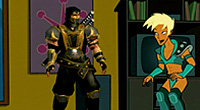
South Park


Permalink: South_Park_Drawn_Togather.html
Words: 339
Location: Buffalo, NY
Category: sex
10/18/05 09:01 - ID#28204
Childporn Article
FOCUS: PORNOGRAPHY
'I had become a monster'
Former teacher in prison for child pornography discusses his obsession and the nightmare it caused
Second of two parts
By DAN HERBECK
News Staff Reporter
10/18/2005
Harry Scull Jr./Buffalo News
"I was addicted to it like people get addicted to cocaine or alcohol . . ." said Jeffrey Hart about child pornography. Hart is a former Town of Tonawanda teacher serving time in a federal prison for possessing child pornography.
Looking back, Jeffrey E. Hart says he is thankful the FBI caught him.
"The day they arrested me, I realized what I had become," he said, "a monster."
Hart, 28, a former teacher who is now a federal prisoner, blames only himself for his fall into the dark and sleazy world of Internet child pornography.
His obsession with child porn resulted in his arrest, the loss of his job and the 57-month term he is serving in a federal prison for sex offenders in South Carolina.
Hart wishes he could go back to the spring of 2001, when he got bored looking at adult pornography and began to seek out images of naked young girls.
He wishes he had looked for psychiatric help before his curiosity became an obsession that turned his life upside down.
"The first few times I saw child porn, I was totally disgusted," Hart told The Buffalo News. "I couldn't click off of it fast enough. But after a while, it became an escape for me. I was addicted to it like people get addicted to cocaine or alcohol . . . I thank God they stopped me when they did."
Hart was arrested in June 2004, when members of an FBI cyber crimes task force showed up at his mother's home in the Town of Tonawanda. He immediately confessed to possessing child pornography and later pleaded guilty to a single felony charge.
Hart was never accused of molesting children, and he insists he never felt the urge to do so. But his conviction made him a registered state sex offender and forced him to resign his job as an elementary and middle school art teacher in the Kenmore-Town of Tonawanda school system. As a convicted felon, he can never teach again.
Losing a job was nothing compared with the pain he caused his mother, father, brother and other family members, Hart said.
"I don't feel bad for myself, but for them," he said. "Knowing how this devastated my family is a pain that is with me all the time, even when I'm asleep."
Hart said he agreed to tell his story publicly because he hopes other men will read it, learn from his mistakes and get psychiatric help.
The introspective ex-teacher is one of a growing number of men throughout the nation prosecuted for viewing and trading child porn images on the Internet. The number of federal prosecutions for such crimes has skyrocketed - from just 366 in fiscal year 1995 to more than 1,550 so far this year.
At least 200,000 child porn Web sites exist, according to Innocence in Danger, a non-profit international group that fights child exploitation. The group estimates that, worldwide, one million children each year are forced into the "commercial sex industry."
Violators caught in Western New York have included several other teachers, a priest, at least two politicians, a police officer, a youth hockey coach and a retired judge. Most cases involve men like Hart, who download images and trade them with others.
The worst local incidents involve men who transmitted images of themselves molesting toddlers or young children - in some cases, their own children or grandchildren.
Why are so many American men willing to risk their freedom, their reputations and family relationships to look at sex images of children?
The men who get involved generally fall into two groups, according to Dr. David G. Heffler, an Orchard Park psychologist who counsels sex offenders.
One group is made up of hard-core pedophiles who look at child porn to indulge their fantasies and who sometimes use the Internet to contact children and teens whom they hope to molest.
The larger group - which includes Hart - consists of men who start out as Internet porn thrill-seekers and wind up in big trouble.
"If the public knew how many men in this community are looking at Internet pornography, day after day, people would be shocked," Heffler said. "A lot of these men start looking at adult porn. The Internet makes it so easy, it becomes a habitual thing. Some actually become addicted to the chemical response that their arousal from pornography releases into the brain."
After a while, for some men, adult porn becomes too routine, Heffler said. They start looking at images of teenage girls. Then, some move toward images of children.
"Part of the nature of man is that he's attracted to things that are considered taboo by society," Heffler said. "I've interviewed men who said they never intended to look at children, but once they did, they were drawn to it, again and again."
Heffler considers all pornography to be bad for society.
"Once a man starts looking at pornography and looking at women as sex objects, less than human, he's on a slippery slope," he said. "He could start looking at kids that way."
Never underestimate the damage that child porn causes for the children who are forced to take part in it, said Elizabeth R. Donatello. She is a prosecutor with the Niagara County district attorney's office who specializes in sex offender cases.
"If you're looking at this material, children are being raped and molested for your entertainment," she said. ""For the victims, it's always on their mind that their pictures are being circulated all over the world."
Forbidden territory
An honor student in the Sweet Home school system, Hart began looking at Playboy magazines at age 12 and adult porn videos as a teenager. In his early 20s, Hart realized that the Internet opened up a whole new world of porn. All he had to do was sit in his room and turn on his computer. "It was easier to get porn than a pack of cigarettes," he said.
Hart kept pushing the envelope, looking for the edgiest adult entertainment he could find. He found Web sites offering pictures of nude teenage girls and started looking at them.
And then, children.
At first, the images repulsed him. Later, he couldn't get enough.
Over the next three years, Hart gradually focused more and more on images of children. Some were posing nude. Others were being molested by adults.
Visibly embarrassed, Hart struggled for words as he tried to explain his attraction to such material.
"At the time, I had some personal demons that I had no way to deal with . . . I was spending a lot of time on the Internet," he said.
"There's a rush you get from doing something that is forbidden. That's part of the attraction. I was being extremely selfish. Pornography is all about a quick fix. Looking at those images makes you feel like you are in control of others . . . My mistake was, I didn't see children there. All I saw was pictures."
Getting caught
By May 2004, Hart had a steady girlfriend and a good job. According to school officials, he was doing excellent work, and there were never complaints about his conduct. But at home, he was looking at child porn almost every day. He stored images in his hard drive and used the Internet to trade them with other men he met through child porn Web sites.
One of those men turned out to be an undercover FBI agent. Hart e-mailed the man seven images of a nude preteen girl.
At 7 a.m. on June 29, 2004, eight federal agents came to Hart's mother's home with a warrant, authorizing them to seize Hart's computer. "My mother woke me up. Two agents came into my room to talk to me," Hart recalled. "They showed me a transcript of me e-mailing back and forth with the undercover agent.
Weeks earlier, while describing the kind of pictures he was looking for, Hart had told the undercover agent, "The nastier, the better."
"When I saw that transcript," Hart said, "that's when I realized what kind of monster I'd become."
Hart's arrest made local headlines. "For five days after the arrest, I just sat in my room, staring at the wall, drinking coffee," he said. "I didn't sleep. I didn't eat. I didn't talk to anyone. I didn't even listen to music during that time.
"For the next five months, the family and friends who stood by me had to tell me when to eat, when to wake up, when to go to bed, when to take a walk. I couldn't function."
The support of his family and counseling sessions with Heffler have helped Hart - not only to move on with his life, but to recognize the pain his actions caused others.
Not everyone was forgiving and supportive. A few friends dumped him altogether. One told him bluntly, "I can't be your friend anymore."
Not a victimless crime
In the months since his arrest, Hart said, he has come to realize that the children in the images he was viewing were victims of vicious and degrading crimes.
"Morally, I consider myself a sex offender," he said. "Yes, there were other people molesting these kids, but I was taking gratification from it. I was helping to create the market for it. I feel like I have blood on my hands."
None of the thrills he got from child porn were worth what he lost, Hart said. His hope is that men who are looking at child pornography now will learn from his mistakes and get help. Here is what he would tell others looking at child pornography now:
"There's no such thing as a victimless crime, when it comes to children. Before I got arrested, I was becoming aware that I had a problem. I tried to stop a couple of times. I couldn't. If you're trying to fight it yourself, get some psychiatric counseling."
What will Hart do after his prison term?
"I'm not even thinking right now in terms of an occupation," he said. "I'm going to do everything I can to make this up to the people I hurt."
e-mail: dherbeck@buffnews,com
Permalink: Childporn_Article.html
Words: 2032
Location: Buffalo, NY
Category: nfl
10/17/05 07:42 - ID#28203
Bills
Permalink: Bills.html
Words: 228
Location: Buffalo, NY
Category: economics
10/16/05 02:57 - ID#28202
Sabres economic inpact article
Return of Sabres puts money into many local pockets
Concessions workers, downtown restaurants, governments all benefit
By DAVID ROBINSON
News Business Reporter
10/16/2005
Click to view larger picture
Mark Mullville/Buffalo News
It's not just fans of the Buffalo Sabres who are happy to see the National Hockey League team playing again.
Click to view larger picture
Ronald J. Colleran/Buffalo News
Mary Beth Billittier of Chef's Restaurant says her business can get a 20 percent boost on nights the Sabres play. Here she greets customers Ronald P. Keellner, left, and Lawrence J. Speiser.
Mary Beth Billittier is thrilled to see the Buffalo Sabres playing again - and not just because she's a hockey fan.
Billittier also is happy because the return of the National Hockey League is bringing back the swarm of fans who eat at Chef's restaurant before games, which can bump up her business by as much as 20 percent.
"It's definitely increased our business on those days. We do get that hockey rush," she said. "Plus, the Sabres come in for lunch before every home game and people come in to see them. We get a double hit from them."
Billittier's not alone. While the return of the Sabres after missing the 2004-05 season due to a lockout isn't causing an economic boom felt throughout the region, it is having a noticeable impact on the area around HSBC Arena.
"We'll see a spike in certain types of business," said Richard Geiger, the president of the Buffalo Niagara Convention and Visitors Bureau.
For starters, the return of hockey is putting about $2 million in extra income into the pockets of the 700 to 900 concessions workers, ushers and other game-night employees, said Sabres spokesman Michael Gilbert.
Those earnings, which average about $50 per game, often are used as a secondary source of income to pay for everything from private school tuition to family vacations. But for workers whose primary job pays in the $20,000 range, that extra $2,000 in earnings during the season can be an important part of their overall income.
The return of the Sabres also means extra business for the downtown restaurants and bars that cater to the fans heading to the arena. Cobblestone, a restaurant located in the shadow of the HSBC Arena at South Park Avenue and Mississippi Street, opens only on nights when there is an event at the arena or for Thursday in the Square concerts.
Cobblestone was open for only about 40 dates last season, but with the return of the Sabres and more than 40 home games, Cobblestone now expects to be serving customers twice as often this season.
"There are 40 more nights of something going on at the arena," Gilbert said.
The return of the Sabres also means extra demand for hotel rooms for the visiting teams, as well as fans from out-of-town attending a game. "We'll see it in hotel occupancy," Geiger said. "When the visiting teams come in, they'll take 20 to 25 rooms. And the even bigger impact will be on the restaurants."
Even the Sabres staff, which had been cut by more than a third during the lockout, has returned to its old level of about 125 people, Gilbert said.
The return of the NHL also is a boon for state and local governments, which will reap significantly larger tax payments from the extra income generated by the salaries earned by the Sabres players and arena workers, along with sales taxes on parking and items associated with the team.
In all, local governments will pick up an extra $1 million in sales taxes, while the state government will see more than $3 million in sales and income taxes that disappeared because of the lockout, according to Sabres figures.
"It's a positive," said George Palumbo, a Canisius College economics professor who closely follows the Buffalo Niagara economy.
The impact of the Sabres also depends on where its fans come from. Fans from outside the region pack the biggest economic punch because they bring new money to the area that flows to hotels, restaurants, the team and whatever other attractions they take in while they're here, he said.
But because local residents tend to have a limited amount of money for recreational activities, from concerts and movies to Buffalo Bills and Sabres games, a spike in interest at one type of event often takes money away from others.
"Unless you're bringing people into the region or getting people to spend money they otherwise wouldn't have spent, it's just taking the money from one set of recreational activity and moving it into another," Palumbo said.
With the Sabres idle, Shea's Performing Arts Center had a strong season last year, with shows like the Rockettes and the Lion King, boosting attendance to around 450,000. Crowds at the University at Buffalo men's basketball team's games last season were 38 percent bigger as the Bulls made a run at an NCAA tournament bid.
"You have a certain amount of discretionary dollars in the marketplace," Geiger said. "Hopefully, we'll see more people coming in from Rochester and on a regional basis. And I think we'll see people continue to come from southern Ontario, mainly because they can't get tickets in Toronto."
The return of the professional hockey also was a welcome boost for Delaware North Cos. Sportservice, the Buffalo-based business that handles concessions for seven NHL arenas, including HSBC Arena and arenas in Boston, Nashville, Columbus, Tampa, Dallas and Edmonton.
e-mail: drobinson@buffnews.com
two pictures from the article one is of Chefs and the other is the HSBC arena
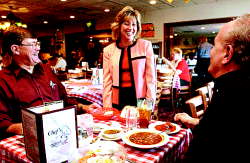
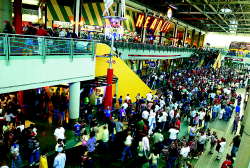
Permalink: Sabres_economic_inpact_article.html
Words: 1019
Location: Buffalo, NY
10/15/05 05:49 - ID#28201
China Continued
Artvoice in China
Bustling downtown Shanghai
(photo: Deborah Ellis)On the day we returned from China there was a front-page story in the New York Times that provided a remarkable finish to our 23,172-mile journey into Asia. The Times article was about Russia and the headline read “With Lenin’s Ideas Dead, Russia Weighs What to do With Body.” Lenin, the leader of the 1917 Bolshevik revolution and the founder of the Soviet Union, lies in a glass box in his Red Square mausoleum adjacent to the Kremlin. He’s been on public display there for the past eighty years, “occasionally sprouting fungi.” Under a lawn behind Lenin’s mausoleum lie the bodies of many other Communist Party luminaries, including Josef Stalin, Brezhnev, Chernenko and Feliks Dzerzhinsky, founder of the Soviet secret police.
“It’s time to get rid of this horrible mummy,” said Valeriya Novodvorskaya, head of the Democratic Union. “I would not care even if he were thrown on a garbage heap.”
The Times reported that an informal poll by a Russian radio station found 75 percent of people said that not just Lenin but all of the Soviet figures should be evicted from Red Square. According to the Times, young Russian adults barely recall the Communist times and show little interest in looking back.
“Lenin?” mused Natasha Zakharova, 23, as she walked off Red Square, admitting she was not sure whose body she had just seen. “Was he a Communist?”
Drummers at a dumpling banquet playing traditional music from the Tang Dynasty 600 A.D. This music is as Avante Garde as anything you'll hear today.
(Click for video)Our experience in China was not much different. We traveled thousands of miles through China and were passed off to at least six different guides, all between twenty-four to thirty-five years old. None of them, or anyone else we spoke to under the age of forty, had much to say about Communist China’s founding father, Chairman Mao Tse-Tung.
“I don’t really know anything about him,” said Lei Lei, 24, our guide in Shanghai. “He was dead before I was born.” She was, however, very knowledgeable about the more durable history of ancient China.
In Beijing, Dina (Yu Fen Mei) told us “Chairman Mao is from my mother’s generation. Very sad. Then everyone wished to get a bicycle and toilet. Today everyone wants a car, a cell phone and a laptop.”
“Nobody cares about Chairman Mao or any of those guys,” said Daniel, 27, our guide in Yichang. “In 1978 they stopped teaching Mao’s Red Book in schools and since 1982 hardly anyone reads it all. All we care about is whether there are any jobs. When I was seven years old I went to a school that was one large room that we had to share with water buffalo that the local farmers used. That was when we were still recovering from Chairman Mao. Today that school is a beautiful building with new classrooms, the latest computers on every desk and Internet access.”
In Xian, our guide Neil (Wang Zhe Jiang), a charming young man who spoke several foreign languages and two Chinese dialects, told us that few young people knew much about Mao and that many older people were now angry.
“My parents were both in the Red Guard youth movement during the Cultural Revolution [1966-1976]. They participated in attacking intellectuals, teachers, elders, and in tearing down our cultural institutions and destroying our history. Now my mother is very angry at herself and ashamed. She told me how she went into an ancient Toaist temple with her Red Guard friends and destroyed all the statues and figurines and painted Maoist slogans on the walls. I said to her ‘That’s a terrible story. I am a tourist guide. I would not even have a job if you succeeded in destroying all our history.’”
Pudong, Shanghai, in 1994
(photo: Xu Xuixian)
The same skyline in 2004
(photo: Xu Jianrong)And so the great Red Menace of the Cold War, world communism, seems to be evaporating. But in China there is something truly unusual going on, something that sets if far apart from India, Pakistan, Japan, South Korea, the European Union, or any of the other rising stars. One of the factors that initiated the Cultural Revolution was Chairman Mao’s paranoia that capitalism was beginning to permeate his communist dream. He was right, and although his final spasms of communist activism, the Cultural Revolution, damaged the country severely, China rolled inexorably towards an industrialized market economy. But what we have now is a country running full-tilt boogie on the capitalist highway driven by a morphing communist government with absolute authority; a country with trillions of dollars in capital, a workforce of over a billion people, no labor unions, and it owns all the property and dictates all the rules.
In cities all over China, entire neighborhoods are being razed to make way for massive new building projects and creating science-fiction-like skylines à la Blade Runner. If people need to be relocated they are simply ordered to move and given whatever compensation the Central Government feels is appropriate. This is the most populous, fastest growing economy in world history. People here in the United States who are focused on Wal-Mart are studying a tree and missing the forest.
In Shanghai there was a construction project right outside our hotel window. I kept waking up in the middle of night to look out at the hundreds of workers crawling over the steel girders and watch the spark of welding torches in the dark night air. Forty percent of all the building cranes on the entire planet are working in Shanghai alone, and there is massive building going on in Beijing, Chongquing, Xian and every other city in China. You can almost stand there and watch a building go up in a matter of hours; and these are all breathtakingly designed, not just buildings that look like window-box air conditioners tipped on their sides.
The Shangri-La Hotel in Shanghai, for example, just added a second tower with 375 rooms, luxury suites, restaurants, bars, health club, swimming pool, spa, etc. Eighteen hundred laborers worked three shifts a day around the clock to get the building completed. In Beijing the pace is even more accelerated because they are preparing to host the 2008 Olympics there. In addition to building a new 80,000-seat Olympic Stadium with a retractable roof, soaring luxury hotels are going up as fast as China can get its hands on the steel and concrete (after the Olympics many of these hotels will be converted to apartments and condominiums). In fact, former Artvoice editor Geoff Kelly, who is now working in the Middle East as a senior media officer for the Qatar Foundation, said that construction projects in Qatar frequently come to a standstill because China will suddenly buy all the available cement on the market and Qatar is forced to wait until supplies are replenished. In Chongquing, (population 31.6 million), they’ve built 60 bridges in just the past few years. Many are sweeping cable stay bridges similar in design to the “signature bridge” model we’ve been haggling about in Buffalo since 1998.
The 2008 Olympic stadium being built in BeijingTourism is exploding in China and the government is doing everything it can to encourage it and profit from it. The Central Government owns almost all the tour companies coming to China and the deals that are out there are the best you’ll find anywhere. Tours usually include airfare to China, hotel, all food—which is excellent—all travel within the country, including any domestic air flights, and busses with tour guides everywhere you go. Packages to China beat trips to any other country in the world. What the Chinese seem to be doing is using the Las Vegas strategy, where they give you really cheap hotel rooms and count on you blowing a boatload of cash in the gambling casinos.
On the China tours you can get travel for pennies but all tours every day lead to you to things like the Jade Factory (government owned); the Silk Factory (government owned); the Pearl Factory (government owned); The Friendship Store (government owned); the Terra Cotta Warriors Factory (government owned), the Great Wall gift shops—you get the picture. So while your food, lodging and travel may not be money-makers for China, almost every other tourism dollar you spend goes right into the Central Government’s cash register. Tour busses clog the streets in every city, although you won’t find many Americans on them. The vast majority of tourists to China are from other Asian countries like South Korea and Japan, and Southeast Asia, the Philippines, Malaysia, or Australia, England and other European countries.
Tour guides receive no pay, only tips. But consider that the average tip to a tour guide is roughly $10 from each person for an entire day of dragging you around, feeding you three times and explaining China for twelve hours. However, some tours are as large as forty or fifty people (ours was only seven), so that means a possible $400-$500 dollars a day, and tour guides pay no taxes. Needless to say, being a tour guide is a very lucrative and competitive job and the training and testing for it is rigorous, requiring language skills and a thorough knowledge of ancient Chinese history.
This is not to say that everything in China is glitz, glamour and tourism. For the most part, we have to assume that since the government owns the tour companies––the same government that censors the Internet, represses Tibetans and members of the Falungong movement, foreign scholars, journalists, democrats, delinquents and the Muslim Uigur minority––tourists see what the Chinese government wants you to see. That’s fine. We were happy to stay in five-star hotels with all the amenities of the Plaza in New York and experience the Great Wall, Chinese Acrobats, kung-fu demonstrations, Buddhist temples, pagodas, gardens, parks, dumpling banquets, the Forbidden City, emperor’s palaces and summer palaces, dance and music performances and walking tours.
Chinese gather around to meet Sarah
(photo: Jamie Moses)But our experience had an unexpected element. Apparently, tourists rarely bring young children along on trips or tours, and the Chinese, who are only allowed to have one child, treasure children. So everywhere we went my little blue-eyed, three-year-old daughter, Sarah, drew throngs of Chinese who literally mobbed her, smiling, staring, snapping photos, asking to pose with her. I am not kidding. It was like trying to walk down 5th Avenue with Jennifer Aniston or window shop with Tiger Woods. At the zoo in Chongquing she was even taken inside the Great Panda bear exhibit to pet the Panda.
But we didn’t always stick to the tourist program. Some days we simply didn’t get on the little tour bus and went off on our own. One day I went for a walk through Shu Yuan Men (the Arts Street) in Xian. This is a dense, bustling neighborhood of narrow streets lined with hundreds of tiny independent shops selling paintings, antiques, jewelry, crafts, art supplies, historical relics and folk art. Price tags are meaningless and generally I got into the habit of offering a third of whatever the price tag said. Vendors always have a calculator handy. The routine is that you look at a price tag, shake your head and begin to walk away. They chase after you and stick a calculator in your face, inviting you to punch in a different number. We punch in numbers until we’re both satisfied–usually less than half the tagged price.
Vendors stalls at the Terra Cotta Warriors site outside of Xian. The man laughing at the end of the video is Neil, our tour guide in Xian.
(Click for video)The smells of food frying in woks in the Shu Yuan Men district beckon one down dark alleys twisting off into mysterious paths. I wandered down one of these in search of a bathroom, and a girl hawking stir-fried shrimp led me to one—a dark, damp dimly lit room. It offered two options: a hole in the ground surrounded by a porcelain squatting pad or a western-style toilet that had to be flushed by filling up a bucket from a faucet poking out of the ground. No sign of toilet paper.
Besides tour guides, farmers don’t pay taxes either. The government gives rural peasants land for free, and as long as they grow food they can keep whatever they make, which, however, is very little. On another off-the-program trip we visited a prison for opium addicts and a peasant rice farmer living several miles outside of Yichang, a town on the Yangtze River surrounded by rice paddies. His home had no electricity; no running water and many of the windows had no glass. The floors of some rooms were simply the dirt beneath the building. He burned coal for cooking and heating, which means in winter the kitchen is the only warm room in the house. As we walked in, three roosters who shared the house with him and his family ran squawking past us. We stayed about a half-hour and the women came home as we were leaving. They broke into big smiles as soon as they saw Sarah and we all talked more gibberish to each other, which no one understood; but the vigorous nodding and smiling said it all.
Handbuilt bamboo scaffolding on a construction project in Shanghai
(photo: Deborah Ellis)Across the road from the peasant farmer’s house was his rice paddy where his family worked, harvesting by hand with their pants rolled up to their knees. With such a large labor force a lot of the work in China is done by hand. We saw hundreds of buildings being demolished—not with bulldozers, but by work gangs wielding sledgehammers. And what was really remarkable was the scaffolding surrounding many of the building projects—bamboo poles and platforms are quickly hand-tied with complex knots by the workers—are added tier by tier as they move up the building.
Soon after leaving the farm we boarded a riverboat for a four-day trip up the Yangtze River and the spectacular cliffs of the Three Gorges. We stopped at numerous towns and sites along the river, took a sampan trip up a tributary and visited the Three Gorges Dam Project. This is a $75 billion project that will produce well over 18,000 megawatts of hydropower (almost eight times the size of the Niagara Power Project). It is China’s biggest engineering project since the construction of the Great Wall. When completed, at 607 ft. high and a mile and a quarter wide, this will be the largest dam in the world. To build the Three Gorges Dam the Central Government of China relocated 1.5 million people and they are going to flood hundreds of towns, villages, farms and small cities. Will there be an environmental impact? Yes. It will obviously affect the wildlife (we saw dozens of monkeys frolicking along the banks of Yangtze and even spotted a tiger). Fish like the Chinese sturgeon and the Yangtze River dolphin will be endangered and increased industrial activity will add further pollutants to the water. There will also be thousands of relics and ancient burial grounds submerged into the river. But from China’s point of view, the dam will control flooding, improve navigation, and create much needed electricity for a country starving for energy. But clearly, this is a building and engineering project that could not happen anywhere else in the world. Imagine telling 1.5 million Americans they were going to be relocated from their homes, farms and businesses so you could build a dam?
The captain of a small sampan sings to tourists while motoring up the Yangtze River.
(Click for video)But China is not America and in an admittedly superficial look at China, such as this article, it is impossible to go into great depth about the country. But let me at least offer some broad observations that should strike even casual sightseers:
In our travels we saw literally hundreds of thousands of people and not a single one was overweight. There’s no obesity problem here. They ride bikes, walk, practice tai-chi outdoors in the mornings and eat lots of fruits and vegetables. In fact, the population of China is 1.3 billion and the U.S. population is only 290 million, but if you put both populations on a scale, we’d probably weigh more.
After weeks of travel we saw only one black person and he at a Japanese restaurant eating sushi and chatting in French.
Every where you go there are flat-screen Samsung monitors. They are on the public busses, and subway cars, train and subway platforms have them every ten or twelve feet, outside of elevators, in hotel lobbies, downtown shopping plazas, street corners, just everywhere. And they program either a very modified type of MTV music or all education all the time. It’s either National Geographic or something similar. But even the MTV-like channels give English language lessons between songs.
The Chinese love slogans and the most frequent one is “A changing China is changing the world.”
Safety! Every traveler remarked on how safe they felt. China does not evoke the fear that travel to the Middle East, Africa, South America or many large American cities inspires.
Crime. There’s little evidence of it. Even after talking to the Chinese crime activity is mostly bicycle theft, pick-pockets, counterfeit products and some prostitution. On pick-pocketing, I have first-hand knowledge. My wallet was lifted, and by a real artist. While standing in a crowd I felt a slight tingle in a front pocket that was shut tight with Velcro and I slapped my hand down immediately and... no more wallet. The crazy thing is that about 10 minutes and a good distance later, I felt something hit my calf. I looked down and my wallet had been returned with all its contents, including credit cards. The cash was, of course, gone.
The idea the Chinese don’t want little girls is fading, and there is a good reason for that. Children are expected to take care of their parents in their old age. Only males used to get good jobs and only males could help on the farm. But China is now an equal opportunity employer, and more than half of our guides were high-wage-earning women with happy parents.
A horn player who sings in a bizarre voice at a dumpling festival. He is playing music from the Tang Dynasty 600 A.D. This music is as Avante Garde as anything you'll hear today.
(Click for video)They take education very seriously. Outside of Beijing we saw a huge, abandoned building project. It looked like a half-finished Disneyworld. It was. A Singapore businessman got three-quarters of the way into building it and ran out of cash, expecting the government would help him finish it. The government didn’t think the Chinese should be wasting their time on such foolishness and sent him back to Singapore. Also, if you are caught having a sexual relationship, you are expelled from school, and that is true right through university. School is so serious that while we were there a mother committed suicide because her son was accepted to a medical school and she didn’t have the tuition. Our guide told us that happens all the time. They live, breathe and die for the children and their education.
The government owns everything. Even so-called private businesses are only 50-year leases that the government gives. The formula is simple: the government owns all the land, period. If you are doing anything in China you are occupying land and the government is your landlord, your employer or your mortgage holder.
Burial in China is mandatory cremation and government provides massive graveyards for urns and stones. Farmers sometimes bury people illegally on their farms. (There is also a strange occupation worth mentioning, a professional crier. They are paid to come to funerals and wail and cry, usually having no idea who the dead person is.)
Daily newspapers like the Shanghai Daily and China Daily are very thin, usually less than 32 pages.
Artists doing public art and sculpture are on salary by either the Central Government or the city or provincial government.
There is an unbelievable amount of traffic on the water and water plays a major role in China’s economy, whether it’s commerce up the Yangtze, shipping ports or tourism. No water is left unused. Seventy percent of all goods in China travel by barge up the Yangtze River.
One message you keep hearing over and over is that the two most valuable things today are water and oil.
All the Chinese people we spoke to want to travel. Most say they would never leave their home forever, but every single one of them wants to travel.
One of the many barges cruising up and down the Yangtze River carrying coal cargo, truck containers, and cars
(photo: Deborah Ellis)What’s Important for Us?
It is in the last three observations above that Buffalo may find a way to once again join the global economy in a meaningful way: Water, China travel, and shipping.
While we were traveling in China, O’Hare Airport in Chicago halted a $15 billion expansion plan, Independence Air cut its flights to one third of what they were and Delta and Northwest filed for bankruptcy. United Airlines, which has lost $10 billion since 2000, is already in bankruptcy as are U.S. Airways and at least 26 other small subsidiary U.S. airlines. The airline industry in America is falling apart.
That’s not the case in China. While we were in China every flight, both international and domestic, had a passenger in every seat. Also while we were in China they announced they were adding five new routes to the Europe and the United States. But most of those go to the Pacific coast. There are nine carriers offering direct flights to China from either Los Angeles or San Francisco. Only two, Air China and Continental, offer direct flights to the East Coast, Air China to JFK and Continental to Newark. YET THE DISTANCE TO BEIJING IS ABOUT THE SAME FROM EITHER COAST! Why aren’t there more direct flights to a country that is sitting on a surplus of a trillion U.S. dollars and a population of over a billion people who want desperately to travel AND an export economy that keeps growing and growing and growing?
I talked to the pilot of our plane after we de-boarded on the way home from China and he told me there was just no more air space left in New York. He said flights are already backed up at Newark, LaGuardia and JFK, and the congestion is getting worse. “There’s just no more air space in the Northeast. Half the time when your flight is late it’s because we’re circling the airport waiting to be allowed to land.” Really?
Motorcycle tricks by Chinese acrobats. Three motorcycles race inside of a very small globe without running into each other. Eventually they had five motorcycles in this tiny space.
(Click for video)Here are a Few Ideas
How about instead of the NFTA focusing on running a Buffalo subway that runs up and down a half-deserted Main St., they focus on reaching out to the federal government in Washington, Air China and other international passenger carriers about turning the Niagara Falls Airport into a new direct route from New York to Beijing?
In the case of both East Coast routes, especially Continental’s out of Newark, the direct flight has been a boon to business. One article, published on newyorkbusiness.com, claimed that Asian businesses were establishing offices in New Jersey, simply because the new route made it convenient for them. Non-stop overseas routes generate thousands of new passengers. One expert put the number at over 150,000 passengers per year per route. Delta, in a bid to launch non-stop flights between Atlanta and Beijing, estimated that such a route would have a $400 million annual impact on the Southeast economy. Businessmen and travelers from Buffalo, Toronto, Montreal, Pittsburgh and Cleveland could fly out of Buffalo and be in Beijing in 13 1⁄2 hassle-free hours.
And cargo? How about NFTA also reaches out specifically to Chinese and other Asian air cargo companies and interest them in a new direct route from Beijing to the Niagara Falls Airport in New York? We’re never going to be a manufacturing center again, but we were once a mighty distribution center. That is something we can return to.
As we stated many times two or three years ago in the series we ran to fight against the Spanish company Cintra taking over Niagara Falls Airport, Buffalo is centrally located between the major population centers of the Northeast and Midwest, making us a natural cargo distribution hub. Buffalo is within 500 miles of more than a dozen major cities, including New York, Boston, Toronto, Montreal, Ottawa, Baltimore, Philadelphia, Pittsburgh, Cleveland, Chicago, Detroit, Cincinnati, Indianapolis and Washington, DC, to name a few. Do an experiment. Draw a circle on a map around all the above named cities and then drop your pencil right in the center of that circle. It’s Buffalo!
Currently, most of the Chinese airfreight to the East Coast flies into the overburdened Newark-New York hub and is distributed from there. Okay. Why not have some of those planes fly into Buffalo International? Well, because the airport’s landing strip isn’t long enough, for one. And let’s face it, there is nothing international about Buffalo International Airport; I can drive in my car to anyplace I can fly to from that airport.
But the NFTA-owned Niagara Falls Airport has the fourth longest runway in New York State. At 9,825 feet, there is plenty of room to accommodate the trans-oceanic planes that are too big for Buffalo—747s, 777s and assorted cargo jets—and plenty of room to grow. An added bonus is that Buffalo is actually almost 200 miles closer to Beijing than New York is (they fly over the Arctic), allowing planes to pack more cargo and less fuel. The highways, railroads and air space are less crowded in WNY, allowing goods to be processed and delivered more quickly and cheaper than in the downstate area. JFK and Newark are so congested that shipping goods on from those hubs often costs more than the price of shipping them from China.
Fireworks at night in Shanghai at the Bund. The Bund is like Times Square on the river front.
(Click for video)And Here’s Another Bonus
If such business could be brought in to Niagara Falls, it would benefit more than just cargo companies. There would be jobs fueling and servicing the airplanes, staffing the airport and conducting other support services.
With the right incentives (including the nonstop flight), Chinese businesses would relocate to WNY. Also, a regular nonstop passenger service could help lure Chinese students to study at our universities, and could attract immigrants. Enough immigrants could mean a Chinatown in Buffalo, particularly if the city or a newly formed nonprofit organization purchases buildings and properties and offers incentives to Asian immigrants in a specific neighborhood.
That would be a genuine tourist attraction that would add character and color to the city. There are Chinatowns in San Francisco, Toronto, Boston, New York, Seattle, Montreal, Portland, Las Vegas, Vancouver and Philadelphia. These are all booming tourist attractions and thriving businesses. And unlike Delphi or Bethlehem Steel, you don’t face some sudden announcement one morning that “Chinatown is closing.”
The enormous Chinatown in Toronto was created as recently as the sixties and seventies when the Chinese brought, as a Toronto website states, “their unique mix of markets, shops, restaurants and theatres to the Dundas Street West and Spadina area. As these early Chinese immigrants decamped for more distant suburbs, they were replaced by other recent arrivals, many from South East Asia. Today, Toronto has at least five Chinatowns spread out from the downtown core to the suburbs. Bright, busy and up all night, it remains a little slice of Asia in the centre of Toronto.”
Deborah Ellis and Sarah Moses inside the Great Panda bear exhibit
(photo: Jamie Moses)Of course, there would have to be major infrastructure improvements to the Niagara Falls Airport to make it a viable passenger and cargo hub. But the combination of both passenger and cargo service to and from Asia should be enough incentive to sink money into upgrading the Niagara Falls Airport.
While air service would probably be Buffalo’s most lucrative link to China, another area that deserves more exploration is nautical shipping. On China’s Yangtze River, there is a constant flow in both directions of barges carrying dozens of fully-loaded tractor-trailers. These barges draw little water and require almost no infrastructure to load and unload; a mobile ramp is deployed that allows the trucks to simply drive onto a barge from a riverside road. Water is the cheapest, lowest impact mode of transport. Buffalo sits on top of the Great Lakes-St. Lawrence Seaway and the Erie Canal, but only gets a few dozen ships in port each year. If Buffalo were a hub for airfreight, it would be smart to explore integrating extended shipping services to the Midwest. As the nation’s highways become more crowded and oil prices rise, a shift toward safer, cleaner shipping alternatives is likely. A typical Great Lakes ship can carry the equivalent of 870 tractor-trailers, and uses only about 10 percent of the energy that those trucks would require.
Even today the border crossings at Buffalo and Niagara Falls together already rank ninth out of 440 of the country’s freight gateways, making a cargo hub even more natural.
Water
Motoring through the canals of Souzhou, a city very similar to Venice in Italy.
(Click for video)When we were in China, the last hotel we stayed in was the Tiany Gloria Plaza Hotel in Xian. This is a really top-notch hotel and one of the newest luxury hotels in the city. There was a little note card on the bedside table. It read:
“Dear Guest, Every day hotels launder a great amount of bed sheets. This not only consumes a lot of water and energy, but also pollutes our rivers and seas with huge quantities of detergent. You make a contribution to preserving the environment by using your bed linen more than once! Please place this card on your bed if you feel that you would like to use it again. Our staff will see to the rest.
Thank you.”
The next night we were back in Los Angeles where we rested before the final leg home. We stayed at RAMADA Inn Hollywood off of Sunset Blvd. When I hit the light switch, I noticed a little card on the night stand next to the bed. It read:
“Dear Guest, We invite you to join with us to conserve water by using your towels and linens more than once. Please place this card on your bed to let our housekeepers know you will participate in this effort.
Thank you.”
I smiled and I thought about the woman from Colorado who traveled with us. One night she complained mightily about the water situation in Colorado, how angry they were that Phoenix, who doesn’t have any water at all, was siphoning all their water from the Colorado River 200 miles away. She complained that they were only allowed water their lawns three days a week while Phoenix, one of the fastest growing cities in America, was filling swimming pools and watering golf courses. She complained about the time her automatic lawn watering timer malfunctioned and watered her lawn every day instead of the three days she programmed it for. Her next water bill was for $245 dollars for water and $600 in fines.
I thought about China again. Water and oil, the most precious things on the planet is what they said. We don’t have the oil in Buffalo. But we do have the water. Let’s make use of it!
Peter Koch contributed writing and research to this article.
If you would like to comment on this article write to Artvoice or email editorial@artvoice.com.
To contribute further material to the web version of this article, send your text to contribute@artvoice.com.
© 2005 Artvoice
Permalink: China_Continued.html
Words: 5470
Location: Buffalo, NY
10/15/05 03:41 - ID#28200
China interesting
From Buffalo News

From Buffalo News

3 Pictures taken By Me of The "Aud Club" During the Bandits season
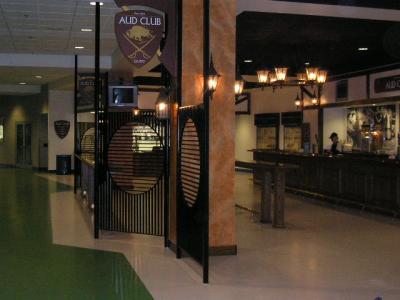
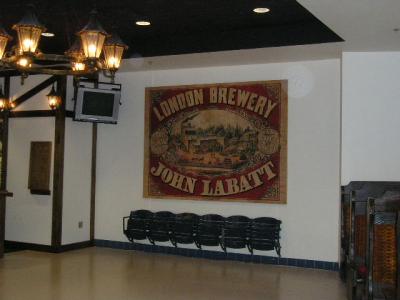
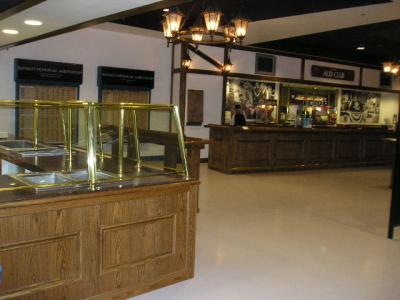
Permalink: China_interesting.html
Words: 166
Location: Buffalo, NY
Author Info
Date Cloud
- 06/16
- 12/15
- 11/15
- 07/15
- 06/15
- 05/15
- 03/15
- 02/15
- 01/15
- 12/14
- 11/14
- 08/14
- 07/14
- 06/14
- 05/14
- 04/14
- 03/14
- 02/14
- 12/13
- 11/13
- 10/13
- 09/13
- 08/13
- 07/13
- 06/13
- 05/13
- 04/13
- 03/13
- 02/13
- 01/13
- 12/12
- 11/12
- 10/12
- 09/12
- 08/12
- 07/12
- 06/12
- 05/12
- 04/12
- 03/12
- 02/12
- 01/12
- 12/11
- 11/11
- 10/11
- 09/11
- 08/11
- 07/11
- 06/11
- 05/11
- 04/11
- 03/11
- 02/11
- 01/11
- 12/10
- 11/10
- 10/10
- 09/10
- 08/10
- 07/10
- 06/10
- 05/10
- 04/10
- 03/10
- 02/10
- 01/10
- 12/09
- 11/09
- 10/09
- 09/09
- 08/09
- 07/09
- 06/09
- 05/09
- 04/09
- 03/09
- 02/09
- 01/09
- 12/08
- 11/08
- 10/08
- 09/08
- 08/08
- 07/08
- 06/08
- 05/08
- 04/08
- 03/08
- 02/08
- 01/08
- 12/07
- 11/07
- 10/07
- 09/07
- 08/07
- 07/07
- 06/07
- 05/07
- 04/07
- 03/07
- 02/07
- 01/07
- 12/06
- 11/06
- 10/06
- 09/06
- 08/06
- 07/06
- 06/06
- 05/06
- 04/06
- 03/06
- 02/06
- 01/06
- 12/05
- 11/05
- 10/05
- 09/05
- 08/05
- 07/05
- 06/05
- 05/05
- 04/05
- 03/05
- 02/05
- 01/05
- 12/04
- 11/04
- 10/04
- 09/04
- 08/04
- 07/04
- 06/04
Category Cloud
- advertising
- art
- body art
- buffalo
- comedy
- concerts
- drugs
- elmwood
- entertainment
- estrip
- event
- events
- food
- freedom
- hockey
- holiday
- holidays
- internet
- issues
- lax
- life
- movies
- music
- news
- nfl
- nhl
- olympics
- party
- peterazzi
- philosophy
- photos
- politics
- poll
- potpourri
- sex
- slideshow
- sports
- summer
- travel
- tv
- wedding
- wishes
- work
More Entries
My Fav Posts
- This user has zero favorite blogs selected ;(

 mobile
mobile
